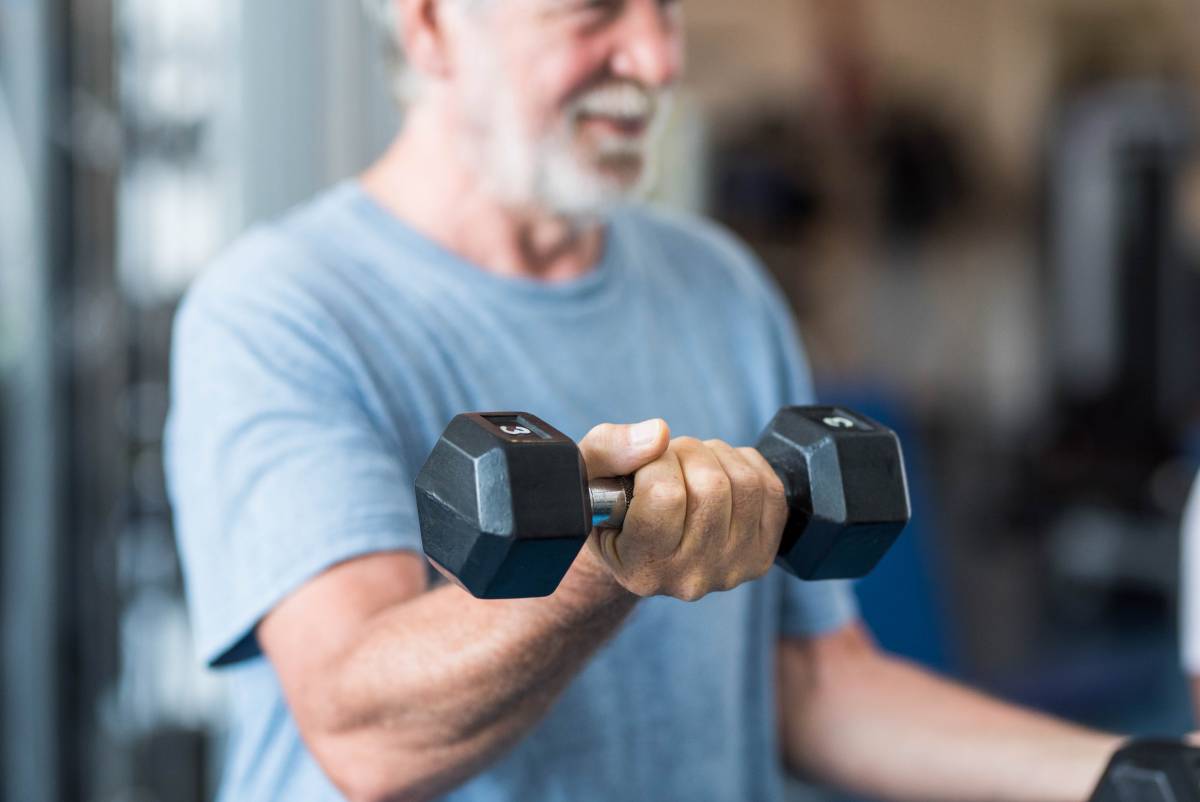Exercising with weights linked to lower death risk, but weights plus aerobic exercise may be better
Exercising with weights on a regular basis is linked to a lower risk of death from any cause – except cancer – according to the results of a study focusing on older adults and published online today (28 September) in the British Journal of Sports Medicine.
The research team found that there was an additive effect ensuring when weekly exercise routines included both weights and aerobic activities.
According to the current guidelines on physical activity, adults should undertake at least 150 minutes of moderate intensity aerobic activity a week, or a minimum of 75 minutes of vigorous intensity aerobic activity, or an equal combination of the two – commonly known as moderate to vigorous physical activity (MVPA).
All adults are also recommended to incorporate activities that work all the major muscle groups. Yet while aerobic exercise is consistently associated with a lower risk of death, it’s not clear if working out with weights might have similar effects.
In a bid to plug this knowledge gap, the research evaluated – both separately and jointly – the potential impact of exercising with weights and aerobic activities on the risk of death among older adults.

The researchers drew on participants from the Prostate, Lung, Colorectal and Ovarian (PLCO) Cancer Screening Trial, which began in 1993 and includes 154,897 men and women aged from 55 to74 years from 10 cancer centres in the US. In 2006, 104,002 of the participants were additionally asked if they had exercised with weights over the past year, and if so, how often they had done so – anything from less than once a month to several times a week. They were also asked about the frequency and duration of both moderate and vigorous intensity physical activity over the past year.
Moderate intensity was described as ‘activity where you worked up a light sweat or increased your breathing and heart rate to moderately high levels’ and vigorous activity as ‘activity strenuous enough to work up a sweat or increase your breathing and heart rate to very high levels’.
Four activity groups were generated based on total weekly minutes of MVPA: (1) inactive, 0 minutes; (2) insufficient aerobic MVPA, 1–149 minutes; (3) sufficient, 150+ minutes of moderate, or an equivalent amount of vigorous, activity; and (4) highly active, 301 or more minutes of moderate, or an equivalent amount of vigorous, activity.
Nearly 100,00 people included in final analysis
In all, the responses of 99,713 people were included in the final analysis, 28,477 of whom died over an average of 9 and a half years of monitoring. Their average age at the start of the monitoring period was 71, and the average weight (BMI) was 27.8 kg/m2 (which is defined as overweight).
Nearly one respondent in four (23 per cent) reported some weightlifting activity; 16 per cent said they exercised with weights regularly between one to six times a week. Nearly a third (32 per cent) were sufficiently aerobically active, either meeting (24 per cent) or exceeding (8 per cent) the guidelines on MVPA.
Exercising with weights and aerobic MVPA were both independently associated with a lower risk of death from any cause, as well as from cardiovascular disease, but not from cancer. Overall, working out with weights in the absence of MVPA was associated with a 9-22 per cent lower risk of death, depending on the amount: for example, using weights once or twice a week was associated with a 14 per cent lower risk.
Similarly, among those who didn’t exercise with weights, aerobic MVPA was associated with a 24-34 per cent lower risk of death from any cause, compared with those who reported neither MVPA nor exercising with weights. But the lowest risk of death was seen among those who said they did both types of physical activity. For example, the risk of death was from 41-47 per cent lower among those who said they met most recommended weekly levels of MVPA and who exercised with weights once or twice a week than it was among those who were physically inactive.
As the study is observational in nature, it cannot establish cause, added to which it relied on personal recall and included data from a single point in time. Specific details on training intensity, training load, volume (sets and repetitions), and for how long participants had been exercising with weights weren’t available, all of which may have influenced the findings.
Our finding that mortality risk appeared to be lowest for those who participated in both types of exercise provides strong support for current recommendations to engage in both aerobic and muscle-strengthening activities [Jessica Gorzelitz et al.]
Conclusion
The study focused only on weights, but there are other types of muscle strengthening exercise, such as callisthenics and Pilates. Using weights can make a body leaner: total lean mass is independently associated with a lower risk of death, say the researchers by way of an explanation for their findings. And if done in a gym, could also be very sociable – another factor associated with a longer, healthier life.
The authors conclude: ‘Our finding that mortality risk appeared to be lowest for those who participated in both types of exercise provides strong support for current recommendations to engage in both aerobic and muscle-strengthening activities.’ They add: ‘Older adults would probably benefit from adding weightlifting exercises to their physical activity routines.’
To see the full version of the article, titled Independent and joint associations of weightlifting and aerobic activity with all-cause, cardiovascular disease and cancer mortality in the Prostate, Lung, Colorectal and Ovarian Cancer Screening Trial, see: https://bjsm.bmj.com/lookup/doi/10.1136/bjsports-2021-105315
Author: Ian A McMillanShare it with














